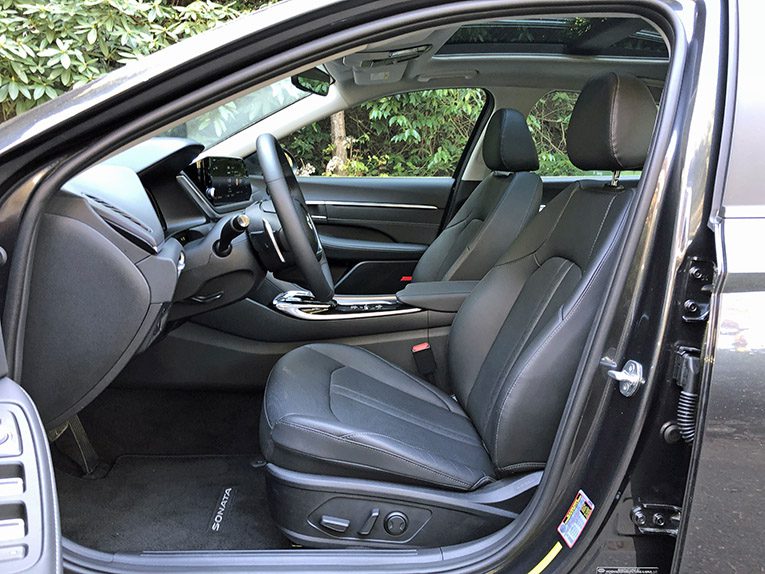Hyundai calls the Sonata its signature product and the Sonata is good enough to stand out in the super-competitive midsize sedan category. For 2020 the Sonata gets a complete makeover, with a sleek, coupe-like exterior design, new powertrain options, an upgraded interior and tons of tech and standard features, all at a very reasonable price.
The five-passenger 2020 Sonata comes in four trims: SE, SEL, SEL Plus, and Limited. Starting prices range from $23,600 to $33,500. There’s also a Sonata Hybrid with starting prices from $25,750 to $31,300.
The gas-powered Sonata has two engine choices. Standard is a 2.5-liter four-cylinder engine that makes 191 horsepower and 181 pound-feet of torque. Or you can opt for the 1.6-liter turbocharged four-cylinder engine that generates 180 horses and 195 pound-feet. Both engines are paired with an eight-speed automatic transmission that shifts quickly and smoothly.
With either engine, there’s enough power for most driving situations. My tester has the turbo. Acceleration is respectable from a stop and the Sonata can speed up on the freeway for merging and passing. However, you can’t describe the Sonata as sporty; other midsize sedans have peppier handling. The Sonata does provide a pleasant and composed ride, even over bumps and rough roads. Shift paddles on the steering wheel let you control shifts, but really, this sedan just doesn’t make you want to drive enthusiastically. If nimble performance is important to you, check out rivals such as the Honda Accord or Mazda6. Visibility is good all the way around. The cabin is quiet with wind and road noise kept at bay.
The hybrid gets a Smartstream G2.0 GDi HEV engine and a six-speed hybrid automatic transmission combined with an electric motor. Combined system power output is 192 horsepower. The Hybrid Sonata has solar panels on the roof that can charge the battery.
EPA ratings for my tester are 27 mpg city and 36 mpg highway with a combined rating of 31 mpg. I got 33 mpg during my week with a mix of city and highway driving.
EPA ratings for the hybrid are 50 mpg city, 54 mpg highway and 52 combined for the Blue trim.
The interior is downright luxurious, especially for the price point. Materials look and feel good and most are soft-touch. Controls are easy to reach and laid out in a sensible fashion. Seriously, other car makers should check out this interior for its driver-centric layout and ease of use. Both rows have enough leg- and headroom for adults to be comfortable.
Standard features include rearview camera, cloth upholstery, six-way manually adjustable driver’s seat, four-way manually adjustable passenger seat, infotainment system with eight-inch touchscreen, Android Auto, Apple CarPlay, USB port, and Bluetooth.
Standard driver assistance technologies include Hyundai’s SmartSense package which includes lane-keep assist, lane departure warning, adaptive cruise control, forward collision warning, automatic high-beam assist, and a driver-attention warning system that can sense if you’re drowsy or distracted while driving.
Available features include proximity keyless entry, remote start, dual-zone automatic climate control, suede and synthetic leather upholstery, genuine leather upholstery, eight-way power-adjustable driver’s seat, four-way power-adjustable passenger seat, heated front seats, ventilated front seats, leather-wrapped steering wheel and shift knob, 12.3-inch digital gauge cluster, 10.25-inch touch screen, navigation,12-speaker Bose premium stereo, HD Radio, satellite radio, second-row USB port, Blue Link telematics, wireless device charging, a panoramic sunroof and Digital Key, a new feature for 2020 that lets you use the Hyundai app on your smartphone to unlock and operate certain functions without having to carry the key fob.
Available driver assistance technologies a head-up display, blind-spot monitoring, reverse automatic braking, surround-view parking camera system, remote parking assist, front and rear parking sensors, and auto-dimming rearview mirror.
The infotainment system is user-friendly and looks great with its sharp graphics.
The gas-powered Sonata has 16 cubic feet of storage in the trunk which is about average for the class. The hybrid has 13.4 cubes.
All Sonatas come with Hyundai’s excellent warranty and maintenance program. The limited warranty covers five years or 60,000 miles. The powertrain warranty covers 10 years or 100,000 miles. Complimentary maintenance is covered for three years or 36,000 miles.
I kept thinking during my week-long test drive that it’s too bad that midsize sedans aren’t as popular as they used to be. The Sonata is one of several excellent vehicles in this category.
The good:
- Sleek, coupe-like looks
- Smooth ride
- Beautiful, spacious interior
- Lots of standard features and tech
- Roomy trunk
- Good buy for the money
- Excellent warranty
The not-so-good:
- Less nimble handling than rivals
Pricing info:
My tester starts at $33,300. Carpeted floor mats are $135. Handling fee is $930 bringing the grand total to $34,365.
Bottom line:
If you’re shopping for a midsize sedan, be sure to check out the Hyundai Sonata in addition to such stalwarts as the Honda Accord and Toyota Camry. While it’s not the most athletic performer in the class, the Sonata boasts a smooth ride, classy interior and is loaded with lots of features and up-to-the-minute technology.















